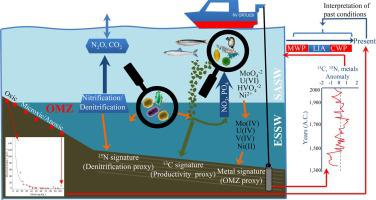Progress in Oceanography ( IF 3.8 ) Pub Date : 2021-02-02 , DOI: 10.1016/j.pocean.2021.102520 Jorge Valdés , Abdel Sifeddine , Marcos Guiñez , Alexis Castillo

|
Mejillones bay presents a permanent and shallow OMZ, whose upper boundary fluctuates between 30 m and 60 m water depth during a normal year. Under this condition, the bottom sediments preserve a geochemical signature of the past oceanic variability. Particularly, biological productivity and bottom dissolved oxygen can be reconstructed using 13C, 15N and trace elements metals measured along sediment cores.
Trace elements like V, Ni, Mo and U preserved in surface sediment of Mejillones bay as a consequence of poorly oxygenated bottom waters, were used to develop a statistical model that allowed the reconstruction of the bottom water dissolved oxygen variability during the last 700 years.
During these seven centuries, the marine sediments of Mejillones recorded three ocean-climatic periods. From 1350 to 1500 CE the bay was dominated by a strong and shallower OMZ, intense denitrification, but a low productivity and flux of biodetritus. Bottom waters recorded oxygen values around a mean of 3.52 µmol L−1, during this period. During the Little Ice Age (1500 to 1850) the OMZ was less intense, and bottom waters recorded mean dissolved oxygen of 5.35 µmol L−1. Finally, during the Current Warm Period (1900 to date) the OMZ has strengthened and is located at shallower depth, generating a bottom water environment with values of dissolved oxygen slightly lower than in the previous period, around 4.51 µmol L−1. Other studies show that during these same climatic periods the Sea Surface Temperatures changed from warm waters before the LIA, a succession of cold and warm periods during the LIA, and warm waters at the beginning of the CWP, but a prevalence of cold waters since the 1940s decade until the present.
The sedimentological approach to reconstruct the paleoxygenation of bottom environments proposed for Mejillones bay must be considered as preliminary and of local-use potential, thus being necessary to explore similar methodologies in other environments in order to support and improve this approach.
中文翻译:

洪堡系统沿海上升区(Mejillones,南纬23度,智利)在过去700年中的氧气最小区域变异性。地球化学特征的新方法
Mejillones海湾呈现出永久性的浅层OMZ,在正常年份中,其上边界在30 m至60 m的水深之间波动。在这种条件下,底部沉积物保留了过去海洋变率的地球化学特征。特别是,可以使用13 C,15 N和沿沉积物芯测量的微量元素金属来重建生物生产力和底部溶解氧。
由于底部含氧量低而保留在Mejillones海湾表层沉积物中的痕量元素V,Ni,Mo和U被用于开发统计模型,该模型可以重建最近700年的底部水中溶解氧的变化性。
在这七个世纪中,梅希永斯的海洋沉积物记录了三个海洋气候时期。从1350年到1500年,该海湾以强而浅的OMZ,强烈的反硝化作用,低生产率和低生物碎屑流为主。在此期间,底水记录的氧值平均约为3.52 µmol L -1。在小冰期(1500至1850年)中,OMZ强度较低,并且记录的底部水平均溶解氧为5.35 µmol L -1。最后,在当前温暖期(1900年至今)期间,OMZ加强并位于较浅的深度,形成了底部水环境,其溶解氧值略低于前一时期,约为4.51 µmol L -1。其他研究表明,在这些相同的气候时期,海表温度从LIA之前的温暖水域,LIA期间的一系列寒冷和温暖时期以及CWP开始时的温暖水域变化,但自从1940年代直到现在。
为梅杰永斯湾提议的底部环境古土壤加氧改造的沉积学方法必须被认为是初步的且具有本地使用潜力,因此有必要在其他环境中探索类似方法,以支持和改进这种方法。










































 京公网安备 11010802027423号
京公网安备 11010802027423号